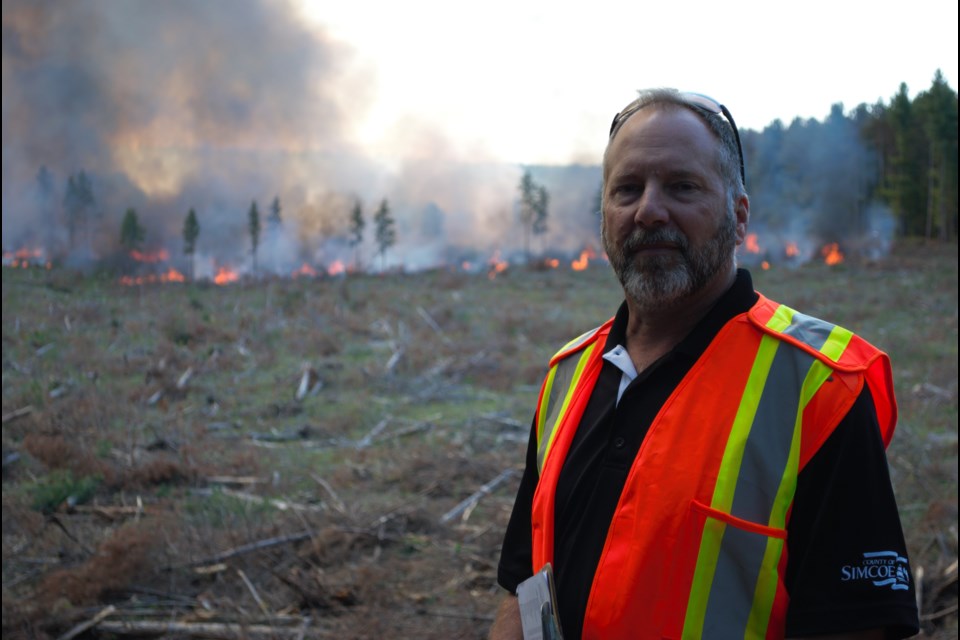While driving around Barrie or Springwater Township on Wednesday, you may have seen some smoke plumes in the sky.
Simcoe County is trying to get back to basics with their controlled burn in part of the Simcoe County Forest in Midhurst this week, getting rid of about 30 hectares of non-native species of trees in favour of planting new native vegetation that will boost the ecosystem and help endangered wildlife thrive in the forest.
“In this case, this is a part of a larger habitat restoration process. We’re trying to zoom in on a particular type of tree planting and a particular type of habitat on this site,” says Graeme Davis, a forester with the county and who is responsible for the Simcoe County Forest and overseeing rural growth and management.
The controlled burn this week served multiple purposes, such as reducing fire risk on the site by burning debris, clearing debris to allow for reforestation and helping to reduce some of the non-native invasive species currently on site.
In particular, burning will reduce the seed and regrowth of Scots pine.
According to Davis, Scots pine is a European species that was brought over to Canada with early settlers. It is still produced in some Ontario areas deliberately as Christmas trees and thrives on dry, sandy sites.
It doesn’t serve much of a purpose for forestry or restoration today due to rising awareness around choosing to plant native versus non-native species.
Fire was necessary over simple removal to get the job done.
“To simply remove them, number one, would have been extremely expensive. You’d need a lot of heavy equipment and have to mulch up the entire site. You’d spend a lot more money and still not get the kind of success we’re going to get with the fire,” says Davis.
“One of the nice things about the fire is, it should burn hot enough to kill off any seeds left behind as well. If we would have just pulled them, there would have been a lot more Scots pine growing back,” says Davis, adding that the fire also releases nutrients into the soil.
The company responsible for the controlled burn, Lands and Forests, has conducted up to 300 controlled burns across Ontario for various reasons.
“Everything is very carefully planned,” says Davis. “You don’t expect things to go wrong, but in case they do, we’ve got secondary control measures in place.”
The Museum Tract controlled burn is a key step in preparing the site for a significant forest restoration and habitat creation project on the property being led by the county.
After the burn is completed, the county will be taking next steps toward re-planting of approximately 160,000 native trees making a home for the Kirtland’s warbler, an endangered bird species.
The Kirtland's warbler is a globally endangered and rare migratory bird.
Ken Tuininga, species-at-risk biologist with Canadian Wildlife Service, was present at the burn and is looking forward to the creation of a habitat for the special warbler in the space left.
“This is a bird that uses an early successional ecosystem,” says Tuininga. “A young Jack pine, young red pine... young oak. When that stuff is from five to 20 feet tall, that’s the time when the Kirtland’s warbler will use that.”
Tuninga also says verbatious flora will also be grown in the space, including goldenrods and asters.
The Kirtland’s warbler resides mostly in Michigan, with some pockets further into Ontario. While there are about 2,300 pairs registered in existence worldwide, Tuininga estimates that there are only about 20 pairs in Ontario.
He’s hoping the addition of this new ecosystem in the Simcoe County Forest will change that.
“It’s an extremely rare bird... we’ve got a ways to go,” says Tuininga with a laugh. “This is a great start. We’re hoping with additional partners and more opportunities we’ll be able to create more pockets of habitats in the area.”
The warblers are expected to flock to the area based on research surrounding their migration pathways. After returning from the Bahamas in the winter months, the warblers have passed through the county, and experts are hoping with the addition of the new ecosystem they will choose Simcoe County as their home going forward.
Peter Burke, an ecologist with Savanta Consultants, is also taking part in the project and has a vested interest in bringing the birds here to prevent them from going extinct.
“We know a lot about what the bird prefers from the habitat... in Michigan,” says Burke. “It’s sand, pine and oak. That forest type has been eliminated by European settlement in southern Ontario.
“This species is a species that should be here,” adds Burke. “All the components – the vegetation and the plant life – kind of hang on in parts of southern Ontario, but nowhere is this system all together.”
“The project is bigger than just that bird,” says Tuininga. “It’s the ecosystem that will help all species at risk. Some are already here. Pollinators as well. It’s a whole package.”
For more information on the Forest and Habitat Restoration Project, click here.



